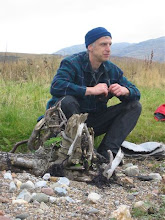


It has been a great year for moths so far and with a bit of effort we have added a few species to the Flanders list. But there are times when opening up the moth trap just doesn't quite reach the peak of excitement and the other day was one of those times. It had looked a potentially good night but the temperature dropped and it turned out to be probably a bit too cool. Arriving at the trap with Prof John Knowler, the resident Flanders moth expert we immediately found virtually no moths on the vegetation around the trap...not a good sign. We then started into the trap and found a gently scattering of moths but no mass burst of fluttering. A few large ears (a moth not a personal comment) and a chevron were new for the year and a smart late ingrailled clay as shown looked good. But in the end there were only 35 moths of 15 species which was a bit disappointing. It was good thing that Prof John was along as when we got to the bottom of the trap there was a little group of very small moths that I took for micros. Now micro moths and small and very difficult to tell apart. It usually takes a real expert and a bit of genitalia dissection to identify them (the micros not the experts) so I tend to just leave them alone. But John grunted a surprised grunt a picked one up for a better look. "Ahhhh, a marsh oblique barred" he said. This had me scrabbling for my book and it turns out that these moths were actually macros (big moths), there were 10 in all, and are a national scarce moth recorded in fewer than 100 10 km squares across the UK and this was the largest single catch that John had caught. As you can see from the photos it may not be stunning but it was by far the best species of the trap so sometimes good things come in small packages.
